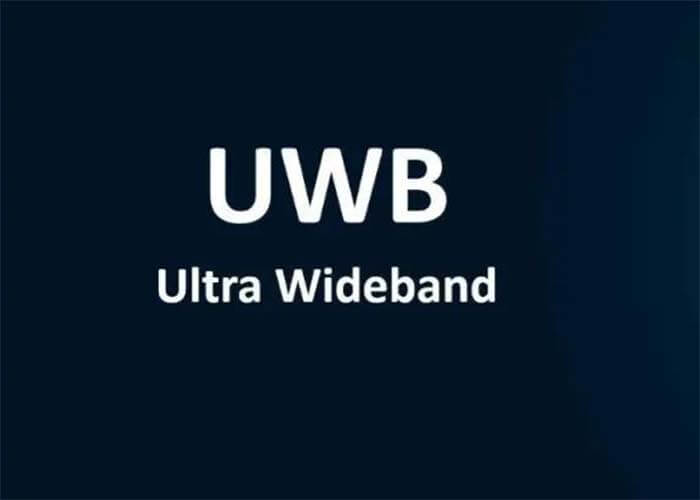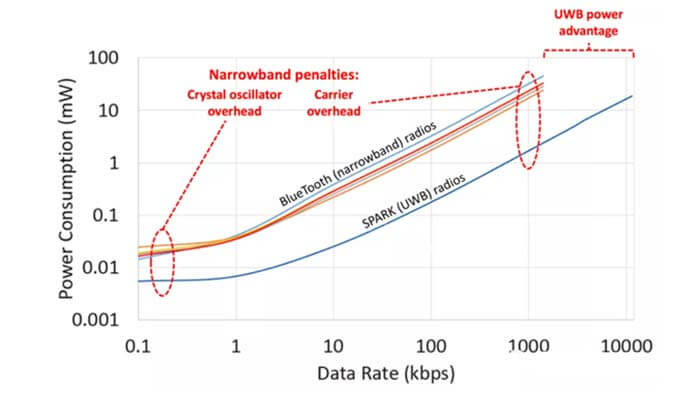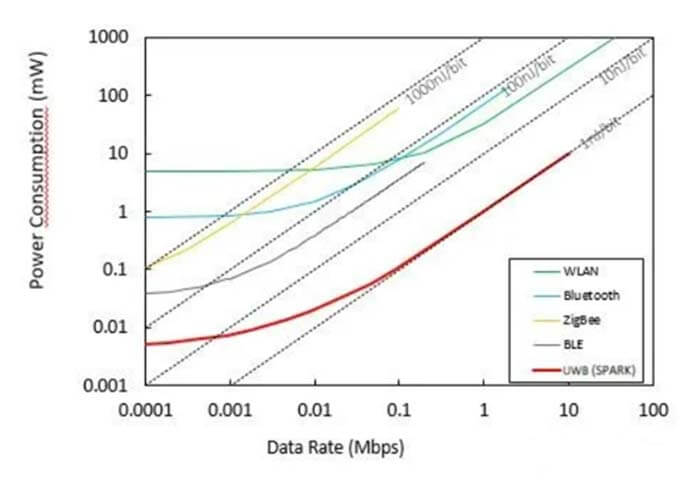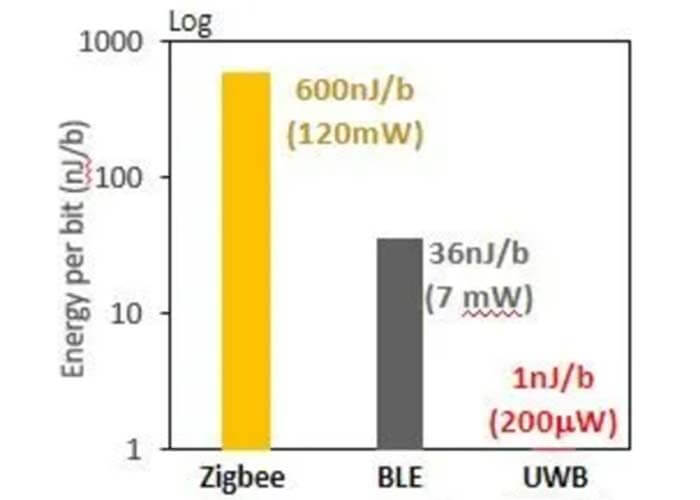
Apple’s first use of UWB is to provide positioning data. Location Supports Many applications in the fields of reality (AR), virtual reality (VR), games, equipment recovery, file sharing, and advertising beacons.
Development of UWB technology
With the growth of wireless communication demand in 1990, the advantages of ultra-wideband (UWB) become more obvious. However, the commercial deployment of the UWB system requires a global agreement in terms of frequency allocation, harmonics, and power restrictions.
With the increase in UWB commercial interest, the developer of the UWB system began to press the FCC and requested to approve its commercial use.
In 2002, the Federal Communications Commission (FCC) finally allowed UWB systems that were not allowed. A few years later, the European Telecommunications Standards Association (ETSI) developed its own regulations, and unfortunately, it is slightly different from the FCC regulations. Other regions are followed, usually consistent with FCC or ETSI.
The UWB system uses a short (ie picosecond to nanosecond) electromagnetic pulse to transmit and receive information. They also have a very low duty cycle that is defined as the ratio of the time and the total transmission time of the pulse.
According to the launch regulations made in 2000, the UWB signal is defined as a signal greater than 500 MHz. Most countries now agree to the maximum output power of UWB, defined as -41.3 dBm / MHz.
As the regulations are in place, the company alliance began to form to standardize the Physical and Media Access Control (MAC) layer. In 2002, the WiMedia Union was established, which is a non-profit industry trade organization to promote UWB technology adoption, supervision, standardization, and multi-supplier interoperability.
In 2002, Wi-Fi is still a relatively new technology. The 802.11b router was launched in 1999, and the theoretical maximum speed of the 2.4 GHz band is 11 Mbit / s.
802.11A standard is also defined in 1999 and promised that the theoretical speed in the 5 GHz band is 54 Mbit / s, but due to its higher chip group cost, there is no attention in the consumer.
In 2003, the 802.11g standard was launched, and the theoretical maximum speed of 54 Mbit / s was provided at the 2.4 GHz band. Despite the fact that the 802.11g standard has achieved great success, the data rate is still limited by the crowded 2.4 GHz band, which is the backbone of the wireless LAN at that time, and the microwave and wireless telephone running in this frequency band!
It is to consider these restrictions, and the market proposes a new generation of UWB radios. With the introduction of regulations, it is difficult to resist the commitment of UWB’s high data rate.
The 7.5 GHz bandwidth allocated between 3.1 GHz and 10.6 GHz is extremely valuable for wireless communication engineers. This is the way to propose short-range (ie, a few meters) file transmission specifications based on the data rate of 480 Mbit / s based on UWB multi-band orthogonal frequency division multiplexing (OFDM).
After several years of development, the first retail product began shipping in 2007. This is a large extent an over-designed radio, multiplexing multiple broadband-wide carriers in a relatively classic manner, which is not a pulsed radio based on fire gap radio.
Although the OFDM UWB has made a lot of noise and the product is very promising, it encountered a challenge in the late 2000s, and the 2008 recession, which leads to a sharp drop in the retail sales of consumer electronics.
In addition, although different UWB alliances are developing new products, the WiFi Alliance does not stagnate.
In 2006, after years of development and negotiation, they released the first draft of the 802.11N standard. It supports multiple input and multi-output (MIMO) concepts in multiplexing channels, and its development purpose is to provide up to 600 MB / s data rate.
Although the final version of the standard did not release before October 2009, the router supported by the draft standard was first shifted first in 2007.
The complexity and strict timing requirements of the OFDM UWB transceiver RF architecture proposed at the time resulted in relatively high production costs and low power consumption.
The combination of the above event and the excessive design of the technology is marked by the high-speed UWB radio demise. At that time, the UWB chipset leader WiQuest has 85% of the market share in early 2008 and stops operations on October 31, 2008.
The UWB Forum is not uniform after the standard is not consistent with the WiMedia Alliance. The WiMedia Alliance is transferred to the Wireless USB promotion group and the Bluetooth special interest group in 2009 after transferring all the specifications and technology. However, the Bluetooth Special Interest Group gave up the development of UWBs as part of Bluetooth 3.0 in the same year.
UWB revival
The history of UWB is a bit complicated. When the high-speed wireless UWB proposal starts to decline, other UWB applications are booming.
From World War II, the rapid development of microwave systems has paved the road to the development of the UWB system. In the 1960s, the Lawrence Lapmore National Laboratory (LLNL) and Los Alamos National Laboratory (LANL) is studying pulse transmitters, receivers, and antennas.
These research projects are not purely academic research; the development pulse system does have a lot of power: UWB can provide ultra-high resolution, which can then be used for object positioning, characterization, and identification.
By the 1970s, UWB radar is mainly used for military applications. With the continuous progress of the research, other applications were found, and in the late 1990s, multiple UWB radars were used for extensive applications: forestry applications, and wearing wall detection in urban areas.
In order to truly understand the appeal of the ultra-wideband, we must first grasp time-frequency two-dimensional and Fourier transform.
Simply, this kind of complement indicates that if you have an infinite period of the time signal, it will have an infinitely small bandwidth. On the other hand, if you have an unlimited short pulse signal, it will have infinite bandwidth.
This means you can use the time to exchange bandwidth. Why do you do that? There are several reasons, but a very important reason is to achieve ultra-high-resolution positioning.
It is determined that the distance between the RF device has two basic methods: you can use the received signal strength (RSS) or the flight time (TOF) of the signal.
RSS is a very simple technique that can be used by any wireless transceiver, which is explained why it is so widely used.
Its accuracy is severely restricted. The perceptual distance between the two still objects will vary depending on the obstacle on its direct path. For example, if you have two devices 10 meters apart, but are separated by a brick wall, with 12 dB attenuation, you will think of these two devices are 40 meters apart.
TOF solves this problem. By measuring the time required from one device to another, you can accurately extract the distance between the two objects.
TOF is clearly a method of accurately setting objects in space. A disadvantage is that you need to process light speed, which is quite fast. In fact, only 333 pico sene is only 3 cm.
If you want to measure the distance between the objects with centimeter precision, the system requires Jana’s second precision. The easiest way to realize this accuracy is a signal that is very short, which requires a UWB signal due to time-frequency binarism.
The possibility of using TOF-accurate measurement distance is largely explained to the UWB in recent years. The accurate positioning market is growing rapidly in many areas, and the growth of two digits should continue to be maintained in the next few years.
A number of companies have joined the UWB ranks. The latest is Apple, which is equipped with UWB chip U1 for iPhone 11, which seems to be its own design.
With the ability to implement real-time positioning systems (RTLs), UWB can achieve a large number of new applications in various markets including industrial 4.0, the Internet of Things, and vehicles.
Time can be exchanged for bandwidth, which can be advantageously used for positioning. But it can also provide other advantages. Next, we will explore another key advantage of UWB in many wireless applications: extremely low delay.
Low delay is king
Wires, just like people’s memory, the advantage of delay is still unlivable.
As a delayed application is mainstream, the pursuit of delays is more and more strong. For example, designers and game players wearing enhanced reality (AR) or virtual reality (VR) headphones will experience delays.
Because there is a disturbing lag between the actions and visual reactions. AR and VR are easy to halt when users are at the beginning of a slight delay.
Industrial engineers will delay unacceptable delays in key sensors and control systems.
Current wireless technology cannot provide acceptable games, AR / VR, real-time video, or industrial Internet access experience, so these applications are still a wired application market in 2022.
Wireless delays have a variety of reasons. It is first the result of the light speed, similar to the wire. However, on the human scale, the light speed is not a limiting factor, as 100 meters of wireless communication only produces a delay of 333 ns.
The second reason is the processing time in the transceiver. But this is usually not a limiting factor because the processor can usually complete the operation of frames in several microcodes.
The third reason is also the most important reason that the transceiver can transmit the speed of its data. In the wireless transceiver, each data frame must be processed after receiving it.
This means that the speed of transmitting and receiving data is an important factor that leads to delays. For example, a 1000-bit frame will result in a delay of 1 ms with a data rate of 1 MBPS. This is called talk time.
In addition to the call time, there is also the time required for the media access control layer, that is, MAC-TIME, which is related to the communication stack used by the protocol, which may include carrier listening, frame confirmation, frame retransmission, stream control, etc.
The MAC time varies depending on the application, and the MAC time can be negligible to become dominant factor compared to the call time. Finally, the MAC time is typically associated with a call time, so radio delay can be provided with a radio to complication.
Combined with all these factors, it is difficult to compare different radio delays. Each technology has its target application, which means that the MAC layer has been developed accordingly. A wireless link that requires 99.999% reliability does not have the same delay as the broadcast system.
The delay is always limited and is derived from a radio talk time, which is a good comparison point. The IEEE 802.15.4 standard behind the ZigBee specification provides a 250 kbps data transfer rate, while BLE 4.2 supports 1 Mbps and BLE 5 2 Mbps.
These data rates provide a few milliseconds of the talk time for BLE, providing IEEE 802.15.4 for tens of millisecond call times. These call times are further enlarged by the MAC layer and result in longer overall delays, which may exceed 100 milliseconds.
A good way to reduce delays is to increase the data rate, Wi-Fi is well applying this method.
As 802.11 standards now support data on a single link to transmit hundreds of Mbps, we can now see a single frame of Miwi second delay. However, this delay is at the expense of power consumption.
Wi-Fi standard supports large data packets of more than 2000 bytes and uses complex modulation that requires power consumption circuitry.
The delay is actually one of the main driving factors behind the development of the 5G network.
Commitment to a few milliseconds, 5G will provide 10 times faster than LTE. However, 5G radio has a disadvantage similar to Wi-Fi, which is very high, hindering their use in most Internet of Internet access.
We can route data from hundreds of kilometers in a few milliseconds, but the last hundred meters of radio using lower power is more time.
UWB combines a gap between long-distance, high data rate transceivers (Wi-Fi and 5G) and short-range low data rates solutions, such as Ble and ZigBee.
UWB uses a fast 2 NS pulse to reach tens of Mbps data rate. This provides a split time than the BLE short order of call time to reach the Miya second delay.
When combined with 5 g, UWB is a powerful candidate providing the last 100 m low delay connection.
UWB sub-second delay and relatively large data rates can achieve a variety of new interactive experiences and applications, and these experiences and applications are previously unable to implement other short-range radios.
A very important aspect of UWB is one aspect of the Internet of Things revolution, low-power operation.
Low power consumption is gold
In everything, all devices require remote control world, and the importance of power consumption is significantly increased.
In a simple sensor node consisting of four parts (sensors, microcontrollers, PMU, and transceivers), wireless transceivers are large contributors to total power consumption.
The power percentage for wireless function can exceed 90% of total power consumption. The wireless headset, the game controller and the computer keyboard, and the power consumption of the mouse are caused by the wireless transceiver.
In the past 15 years, the reduction of power consumption has been promoting the development of wireless chips.
After years of development, BLE was approved in 2006 to solve the power consumption of Bluetooth. Recently, Bluetooth 5.2 adds some features to reduce the consumption of different applications, including audio. However, most of these modifications are progressive.
Fundamentally, the reduction in power consumption is limited by the physical limitations of the architecture; the carrier-based transceiver always requires a large amount of power to start, stabilize and maintain its RF oscillator.
After 20 years of optimization, Bluetooth has reached the point of revenue. All narrowband technologies are this: obtaining a number of orders requiring wireless transmission. The reason is as follows:
In the above figure, you can see two significant power losses in all narrow-band radio architectures (such as Bluetooth):

In the above figure, you can see two significant power losses in all narrow-band radio architectures (such as Bluetooth).
Crystal oscillator overhead (lower left) has weakened low data rate performance. Bluetooth uses a 20 MHz crystal oscillator, which requires a few milliwatts to start and stabilize.
UWB radio can operate using a pulse that does not require a high-frequency crystal oscillator and can be designed to operate at a low timing power consumption.
Carrier overhead (middle) affects high data rate performance. As described in Section 4, a large amount of data requires a large amount of time and power on a narrow bandwidth channel (such as a channel used in Bluetooth radio).
You can transfer a large amount of data when distributed in broadband width so that the duration of the transmitter keeps open and significantly reduces power consumption. This means that for the same consumption, UWB can transmit more data. (Top right corner)
If you start designing a short distance (50-100m) wireless protocol from scratch to minimize power consumption and delay and maximize data rate, you may experience the following thoughts:
First, try to minimize the boot time of the transmitter and receiver. To this end, each signal should be as short as possible. From the time-frequency binary we know, the short signal bandwidth is wide, so the solution will use broadband communication, so the authorized UWB spectrum is selected.
Second, make sure the transmitter and receiver can start and close as soon as possible. This makes it difficult to use a transceiver using a traditional high-precision RF oscillator. The best architecture that minimizes power consumption is to use UWB pulse radio without the need for RF carriers itself.
As can be seen from the data in the above figure, the method provides short-distance communication with a low power distribution as possible.
Since UWB does not use a high-frequency carrier oscillator, the UWB transceiver can be turned on very quickly, and the data rate transmitted at a given power level is much higher than that of narrowband radio.
The secret of UWB is finally announced
UWB provides a unique combination of accurate positioning, ultra-low power, ultra-low delay, and high bandwidth, which is unmatched by any other short-range wireless technology.
2022 ultra-wideband deployment focuses on precise positioning and location-based services: security key masters enter, handles payment, and indoor navigation. It is about to introduce low-power and battery-free data network networks with high Bluetooth 10 times bandwidth.
Bluetooth has achieved great success in low bandwidth, low-fidelity communications (such as wireless headphones and earplugs). So why is Apple designing another transceiver in the iPhone 11? That is because UWB exceeds the emerging application of Bluetooth design restrictions, especially accurate positioning.
How is the narrowband protocol like Bluetooth has basic limitations, which makes it less suitable as very low power, low delay, and battery applications as UWB:
Data rate limit
The Bluetooth specification limits the air bandwidth to only 3 Mbps and is limited to 3 Mbps in most systems. UWB can run at dozens of Mbps.
Low data rate power
Even at the lowest data rate, the oscillator overhead and long packet duration can also keep the smallest power of Bluetooth at a few million.
UWB tailored to low-power operation and data flow can transmit 1 kbps at a speed below 10 μW, thereby making it possible to make the battery-free battery sensor that supplies power from energy.
Delay
Bluetooth delay usually exceeds 100 milliseconds, and the headset user treats it as an echo, long-term audio delay, and calls.
This delay makes Bluetooth interactively apply interactive applications such as game controllers and Ar / VRs, which is unacceptable for industrial sensors and control systems. UWB provides a mid-second delay in the machine control and interactive entertainment system for close-time.
Position
Location services and precision positioning are well-known strengths known as UWB, which can measure relative positions with 10 cm accuracy. This is unable to achieve Bluetooth, it is difficult to get the precision of several meters.
Anti-interference
The 3-10 GHz band becomes crowded. In addition to LTE, 5G, and WiFi, including recently released WiFi 6e occupy different parts of this spectrum.
It is possible to achieve a robust UWB communication but must be done carefully to operate without hindering all other carrier-based signals and effectively reject them.
For short distance, low-power applications, UWB is better than WLAN and Zigbee and classic Bluetooth and BLE:

This chart compares the energy efficiency of the 200kbps full link of ZigBee, Ble, and UWB.

When you add all the power consumption required for the excitation and stable carrier frequency and the transfer of narrowband data, the sum is 1-2 quantities (designed for low power operation) than the UWB.
Today’s UWB is different from the UWB of 100 years ago. It is the first for 20 years, the first new unlicensed spectrum wireless technology contained in the smartphone, and other mobile phone manufacturers have also followed the approach of Apple.
UWB’s super capabilities directly solve the power, bandwidth, and delayed needs of narrowband unable to provide.
UWB is ideal for dominating many emerging low-power, low delays, higher data rate applications, and paving the way for battery-free applications.
Besides the UWB Will Open A New Era article, you may also be interested in the below articles.
4G vs 5G: What is the difference between 4G and 5G?
How to Choose the Best Antenna for Lora?
